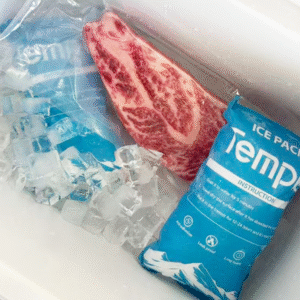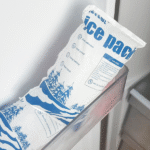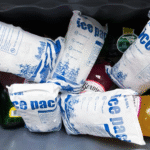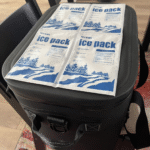Cómo almacenar bolsas de hielo seco vacías entre usos: Mejores prácticas y consejos
Almacenar adecuadamente las bolsas de hielo seco vacías es esencial para mantener la seguridad, cumplimiento, y eficiencia en sus operaciones de cadena de frío. Siguiendo las mejores prácticas para la ventilación., control de temperatura, y técnicas de almacenamiento adecuadas, podrás prolongar la vida útil de tus bolsas y reducir el riesgo de contaminación. Esta guía lo guiará a través de los pasos clave para garantizar que sus bolsas estén listas para ser reutilizadas., totalmente compatible, y seguro para el manejo.

¿Cuál es la mejor manera de almacenar bolsas de hielo seco vacías??
El almacenamiento adecuado de las bolsas de hielo seco vacías es crucial para evitar riesgos de seguridad., como la acumulación de CO₂, y para mantener la integridad de las bolsas para uso futuro.. El ambiente de almacenamiento debe estar bien ventilado., Frío, y secar para asegurar que las bolsas permanezcan intactas y libres de moho o daños.. Almacenar las bolsas de una manera que permita la ventilación del gas y minimice la exposición a la luz solar o al calor puede ampliar significativamente su utilidad..
Pautas de almacenamiento de claves:
-
Ventilación: Guarde siempre las bolsas de hielo seco en un espacio bien ventilado para permitir que se disipe el CO₂ residual..
-
Temperatura: Mantenga las bolsas en un lugar fresco., área seca alejada de la luz solar directa. Las temperaturas ideales de almacenamiento oscilan entre 50°F y 85°F (10°C–29°C).
-
Humedad: Asegúrese de que las bolsas estén completamente secas antes de guardarlas para evitar el crecimiento y la degradación del moho..
-
Caza de focas: Nunca selle bolsas alrededor de hielo seco residual.. Esto puede provocar un aumento de presión y posibles roturas..
¿Por qué es importante el almacenamiento adecuado de las bolsas de hielo seco vacías??
Consideraciones de seguridad:
El hielo seco se sublima en gas co₂, que puede acumularse si no se le permite ventilar. Almacenar bolsas de hielo seco en contenedores herméticos supone un importante riesgo para la seguridad, ya que el gas atrapado puede hacer que se acumule presión, potencialmente provocando rupturas o explosiones. Manteniendo protocolos de almacenamiento adecuados, Puede prevenir situaciones peligrosas y garantizar una manipulación segura de las bolsas..
Rentabilidad e impacto ambiental:
Reutilizar bolsas de hielo seco puede ayudar a reducir los costos de embalaje, minimizar el desperdicio, y apoyar los objetivos de sostenibilidad. El almacenamiento adecuado prolonga la vida útil de las bolsas., reducir la necesidad de comprar nuevos con frecuencia y contribuir a un proceso de cadena de frío más ecológico.
¿Cómo se deben almacenar las bolsas de hielo seco vacías para garantizar la seguridad y el cumplimiento??
1. Entorno de almacenamiento y tipos de contenedores:
Para evitar daños y garantizar una ventilación eficaz del gas, Guarde siempre las bolsas de hielo seco en un contenedor ventilado. Utilice materiales como contenedores de polietileno, contenedores de poliestireno, o refrigeradores de espuma aislados con tapas sueltas u orificios de ventilación. Evite rígido, cajas selladas, ya que pueden atrapar CO₂ residual y aumentar el riesgo de ruptura.
| Factor de almacenamiento | Práctica recomendada | Qué evitar |
|---|---|---|
| Ventilación | Contenedores abiertos, tapas transpirables | Contenedores herméticos |
| Aislamiento | Espuma gruesa o revestimientos aislantes. | Materiales que se agrietan con el frío. |
| Temperatura | Guardar en lugar fresco, espacios secos (50°F–85°F) | Exposición extrema al calor o al frío |
2. Limpieza y control de humedad:
Asegúrese de que las bolsas de hielo seco estén completamente seco antes de almacenar. Cualquier humedad residual puede provocar crecimiento de moho o comprometer el aislamiento de la bolsa. Considere usar paquetes desecantes para absorber la humedad, especialmente en entornos húmedos. Inspeccione periódicamente las bolsas para detectar signos de condensación y asegúrese de que las áreas de almacenamiento estén libres de suciedad., polvo, o plagas.
¿Cómo se limpian y reacondicionan las bolsas de hielo seco que entran en contacto con alimentos??
Proceso de limpieza paso a paso:
-
Inspeccionar por daños: comprobar si hay lágrimas, puntas, o signos de desgaste. Retire las bolsas dañadas de la reutilización..
-
Eliminar el hielo seco residual: Deje siempre que el hielo seco residual se sublimar completamente en un espacio bien ventilado.
-
Limpiar las bolsas: Lave con agua tibia y jabón suave para eliminar cualquier residuo visible.. Evite productos químicos agresivos que puedan dañar el material..
-
desinfectar: Utilice un Desinfectante para contacto con alimentos registrado por la EPA para garantizar que las bolsas sean seguras para su reutilización. Siga las instrucciones del fabricante para conocer el tiempo de permanencia adecuado..
-
Secar completamente: Deje que las bolsas se sequen al aire por completo antes de guardarlas.. Evite colocar bolsas bajo la luz solar directa para evitar daños por rayos UV..
¿Cuáles son las consideraciones clave para almacenar diferentes tipos de bolsas de hielo seco??
Las bolsas de hielo seco vienen en diferentes materiales., y las necesidades de almacenamiento para cada tipo pueden variar. Por ejemplo, Las bolsas de plástico resistentes son duraderas pero sensibles a la luz ultravioleta., mientras que las bolsas textiles no tejidas son más transpirables pero requieren un secado cuidadoso para evitar el moho..
| Tipo de bolsa | Material | Recomendaciones de almacenamiento |
|---|---|---|
| Plástico resistente | Polietileno/espuma | Guárdelo plano o ligeramente doblado, lejos de la luz solar. |
| Textil no tejido | Fibras sintéticas/espuma | Secar completamente al aire y evitar la compresión. |
| Híbrido forrado de aluminio | Lámina/espuma reflectante | Tienda plana, Evite pliegues afilados y superficies rugosas. |
2025 Tendencias en hielo seco y envasado de cadena de frío
A medida que la industria de la cadena de frío continúa evolucionando en 2025, Hay un énfasis creciente en la sostenibilidad y los envases reutilizables.. Innovaciones como bolsas de hielo seco biodegradables, sensores inteligentes Integrado en el embalaje para controlar la temperatura y el gas., y revestimientos con desecante integrado están ayudando a las empresas a mejorar la seguridad, Reducir el desperdicio, y mejorar la eficiencia operativa.
Tendencias clave para ver:
-
Bolsas de hielo seco reutilizables: El uso de sistemas de embalaje reutilizables va en aumento, ofreciendo importantes ahorros de costos y beneficios de sostenibilidad.
-
Embalaje inteligente: Los sensores en el embalaje permiten el control en tiempo real de la temperatura y la presión de CO₂, Garantizar la manipulación segura de los productos durante el tránsito..
-
Materiales biodegradables: Las empresas están explorando alternativas ecológicas a los materiales tradicionales de las bolsas de hielo seco para reducir su huella ambiental..
Preguntas frecuentes (Preguntas frecuentes)
Q1: ¿Es seguro guardar bolsas de hielo seco vacías en el congelador??
No, no es seguro. Los congeladores son espacios confinados donde se puede acumular CO₂, creando un peligro potencial para la seguridad. Utilice siempre un almacenamiento ventilado.
Q2: ¿Con qué frecuencia debo limpiar las bolsas de hielo seco vacías??
Limpiar las bolsas después de cada uso para evitar el moho., olores, y contaminación. Un detergente suave y secar al aire son suficientes para la mayoría de las bolsas..
Q3: ¿Qué debo hacer si se daña una bolsa de hielo seco??
Retire cualquier bolsa con rasgaduras visibles o signos de desgaste.. Las bolsas dañadas pueden comprometer la integridad de su cadena de frío y presentar riesgos para la seguridad..
Conclusión y recomendaciones
Para almacenar bolsas de hielo seco vacías de forma eficaz, asegurarse de que se mantengan en un bien ventilado, Frío, y seco ambiente. Siga una rutina adecuada de limpieza e inspección para mantener la calidad y seguridad de la bolsa.. Considere el material de sus bolsas y sus requisitos de almacenamiento específicos para maximizar su vida útil.. Las inspecciones periódicas y el almacenamiento adecuado pueden ayudar a reducir el desperdicio, mejorar la rentabilidad, y garantizar el cumplimiento de las normas de seguridad.
Siguientes pasos:
-
Designar un área de almacenamiento con ventilación adecuada.
-
Implementar un protocolo de inspección y limpieza de bolsas. para cada ciclo de uso.
-
Monitorear las condiciones de almacenamiento regularmente para evitar la acumulación y degradación de la humedad..
Acerca de Tempk
Y tempk, Nos especializamos en soluciones de cadena de frío, ofreciendo alta calidad, Bolsas de hielo seco reutilizables y embalajes diseñados para la seguridad., durabilidad, y cumplimiento. Nuestros productos le ayudan a mantener la integridad de la temperatura y al mismo tiempo reducir los residuos y los costos operativos.. Comuníquese con nosotros para obtener orientación experta sobre cómo optimizar sus procesos de cadena de frío..























